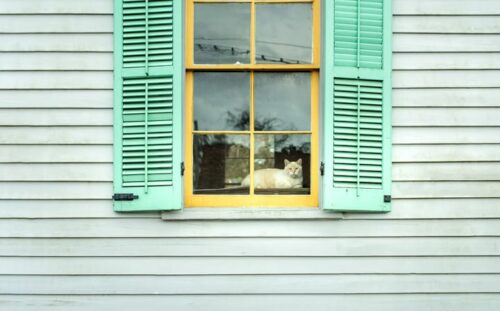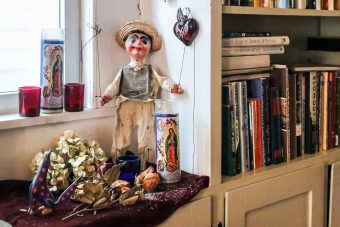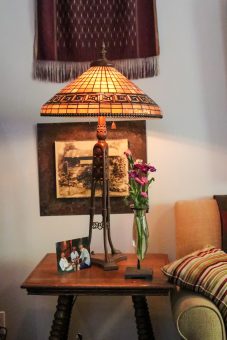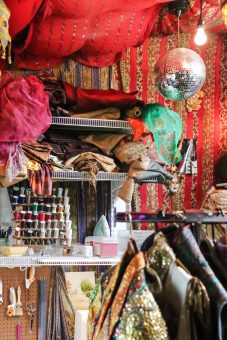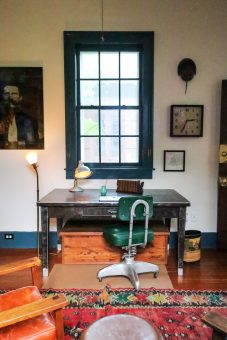Take an interactive 3D tour of this home with our Shotgun House Design Guide. Virtually walk through each home featured on our 2021 Shotgun House Tour, see detailed floor plans, and discover information about the paint colors, materials and products used. You’ll also receive a printable design guide booklet with more information about each home and articles about the history of New Orleans’ shotgun houses. Learn more & get the guide!
It’s the thrill of the antique hunt that’s fun for Bryan Block and Jeff Keller, who have filled their home with finds from their favorite stores, estate sales and unique spots discovered during their travels.
“We just pick up odds and ends,” said Block, whose maternal family sold antiques. “We prefer things that are older and have character.”
Block and Keller were on the hunt for a smaller home after two previous house renovations — the first a Carrollton Avenue home designed by famous 19th-century architect Thomas Sully, followed by a 10,000-square-foot Canal Street property that they ran as The Block Keller House bed and breakfast for 11 years. (It’s now The Canal Street Inn.)
When their search turned up a unique shotgun on Burgundy Street in the Faubourg Marginy, it initially didn’t excite them. The 1,800-square-foot house resembles an off-set double shotgun. The right side abuts the sidewalk; the left side is set back about 15 feet, creating space for a small front garden.
Advertisement
“It was kind of an odd arrangement. It had funky bad shutters on it, and it was kind of a periwinkle blue,” said Block, executive director of the Historic District Landmarks Commission and the Vieux Carré Commission.
“Our first reaction to it was ‘not interested’,” he added. “But by the time of the open house, which was probably that same week, we got here … and we said, ‘This is the one’.”
After opening the half-pane, Eastlake-style front door, they saw built-in, floor-to-ceiling bookshelves and cabinets that span the full length of the living room’s left wall. The light-filled kitchen stretches across the rear of the house, offering views of the generous backyard, which contains an oversized deck surrounding a large elm and a metal-roofed shed at the rear of the lot.
When the couple purchased the home in 2011, Block — an architect with a Master of Preservation Studies degree from Tulane School of Architecture — set about researching its history. Originally, the house’s right side was a cabin that was one-room wide and two-rooms deep, he said. (Its original ceiling beams are still present.) Later the structure on the left side was added. It originally ended at the now free-standing brick chimney. The couple’s dining room on the other side of the chimney was another addition, as was the kitchen and the shed.
“I researched the house in the real estate conveyance records and found that the property was described as having ‘improvements’ when it was sold in 1840. …The 1908 Sanborn (Fire Insurance) maps show the offset condition of the two halves and also that each side had been extended further back on the lot,” Block said in a 2015 New Orleans Advocate article about the home.
The house’s façade also points to its changes over time. It now features Italianate elements, including three milled brackets on each half of the house and arched windows — a four-over-single pane on the left and a six-over-six-pane on the right, along with drop siding. At some point during the house’s history, the left side’s front door and window flip-flopped locations, Keller said.
Block and Keller replaced the former board-and-batten shutters with louvered ones and coated them in Benjamin Moore’s Narragansett Green. The color is repeated on portions of the trim and brackets, while a sunny yellow covers the siding.
The home’s interior had been renovated, giving the couple the perfect backdrop for their eclectic décor. Mission Revival pieces and other antique furniture sits atop vintage Oriental rugs. Paintings and photographs hang on the walls. Books — the couple are both avid readers — and unique finds in the built-ins and along windowsills add the final decorative layer.
The house’s right side contains the bedrooms and bathrooms. The couple updated the master suite’s bathroom within the past year; it was the first major renovation project they tackled in this house.
Because Keller works in finance from home, they recently converted the light-filled front room from a guest space into an office. (His former home office was one of the shed’s two spaces.)
The new office space is filled with an antique desk, a chair and a lamp from La Belle Nouvelle Orleans on Magazine Street, one of their favorite antique stores. An authentic Stickley chair was found in a Virginia barn, while other furniture came from Keller’s family in South Carolina. They added artwork, including watercolors by Keller and images by photographers David Knox and Frank Relle. The room’s trim and doors are painted Benjamin Moore’s Newberg Green. It was chosen to mimic the trim and shutter color outside.
“We really, really thought about it a lot,” Block said of the color choice. “Because from here you see the front of the building, it was really important that these colors kind of bring that in.”
An alcove-like hallway links the house’s right side to the long living room on the left side. The couple added Asian architectural elements found at a pop-up sale on St. Claude Avenue as brackets for the large cased opening between the two spaces.
The living room contains more artwork by Knox, as well as a black-and-white photo by Wallace Merritt and a painting by John Matteo of a costumed Keller on Mardi Gras. In the built-in’s glass-front cabinet, there are pieces of pottery and other finds made by Block’s grandfather, an amateur archaeologist and collector. Photographs of the couple’s families fill the section built around one of the room’s six-over-six pane windows.
Block and Keller added wainscoting along the dining room’s left wall and behind the small TV in one bookcase section. With exposed wood of various colors, it shows the patina of wood salvaged from a Creole cottage dependency that a friend had demolished. “It ties the two spaces together,” Keller said.
The kitchen, which the couple plans to renovate in the future, is located behind the dining room and includes a sitting area with a Stickley sofa and a cabinet displaying their FiestaWare collection. It’s where everyone hangs out when the couple entertains, particularly since the kitchen’s double doors open to the backyard. Block and Keller both enjoy what they call the creative process behind gardening, and they have filled the yard with a fountain, wind chimes and as many native plants as possible.
Steps lead to the shed, whose left side the couple refers to as the costume shed. It houses their extensive collection of costumes created for Halloween and Mardi Gras, when they march with the Society of Saint Anne.
“That takes it up a notch,” said Block of their participation in the walking krewe. The planning for their elaborate costumes starts months in advance. To make the outfits, Block bought a sewing machine and taught himself to sew via books and YouTube videos.
Instead of relegating the costumes to a closet, the shed allows the couple’s friends to “come over and try everything on. It ends up being a fun room to hang out in,” Block said.
The space has the feel of a glamorously funky Bedouin tent, thanks to the racks filled with brocade vests, sequined jackets and other ensembles; the painted floors; Moroccan-style chandeliers; and the ceiling covered in fabrics and textiles from Sumatra, where Block’s parents lived for several years.
In the corner is an antique pharmacy chest, found by Keller at La Belle Nouvelle Orleans. “I got that for Bryan so he could store beads,” costume jewelry and other sewing notions, Keller said. “Bryan sews gorgeous stuff. I just buy stuff and hot glue it together.”
Click gallery images to expand. Photos by Liz Jurey
Advertisements

